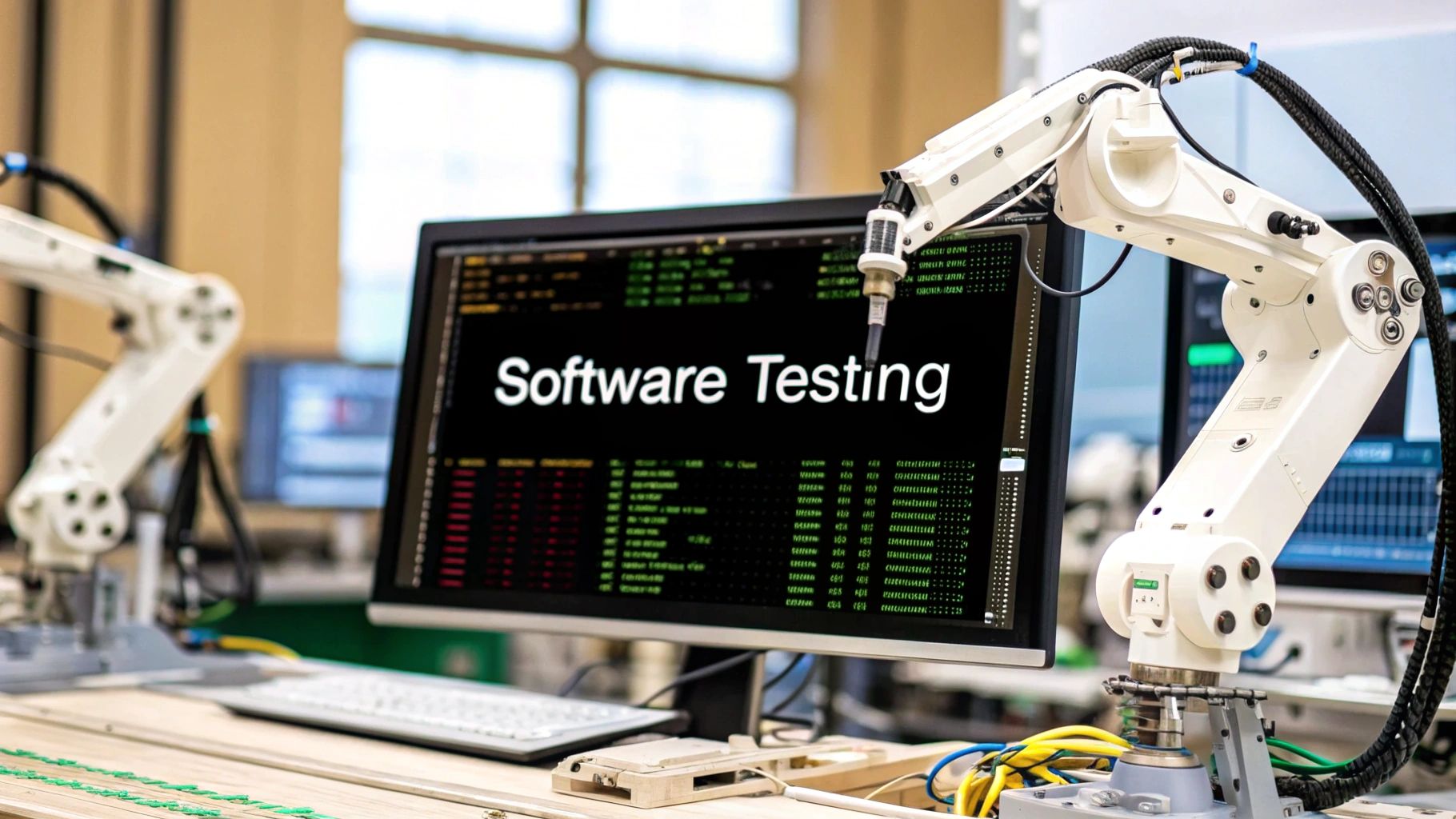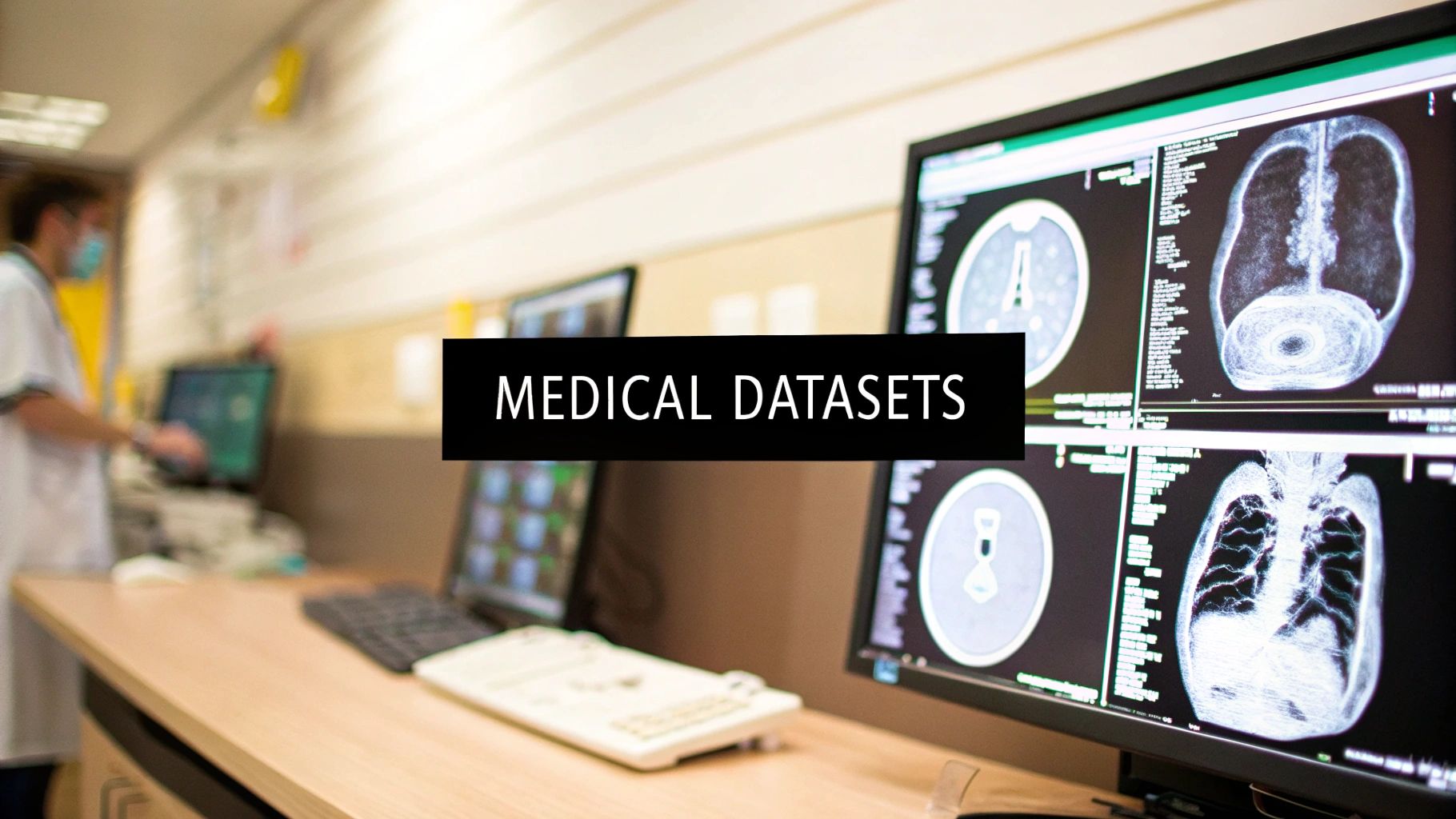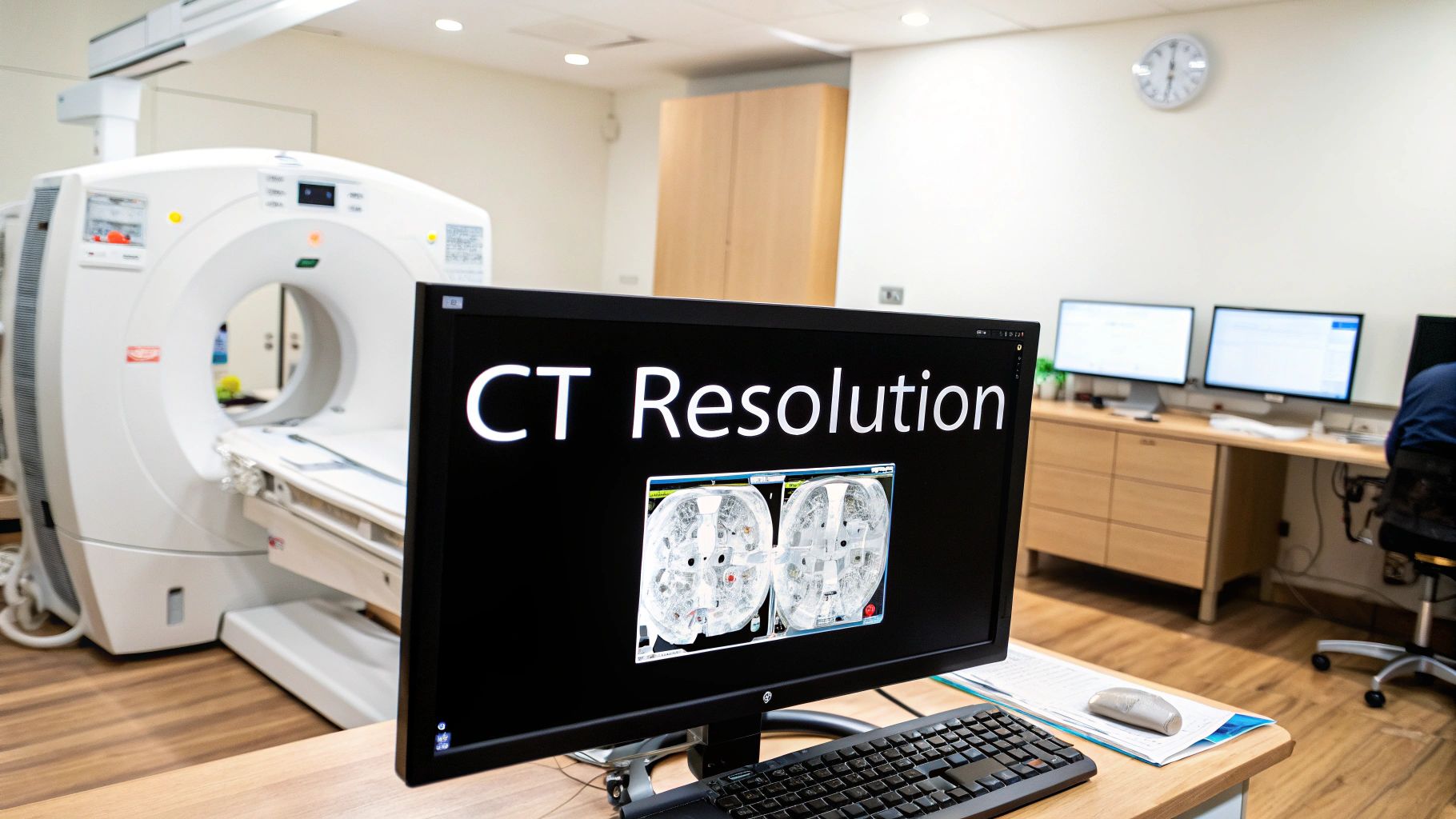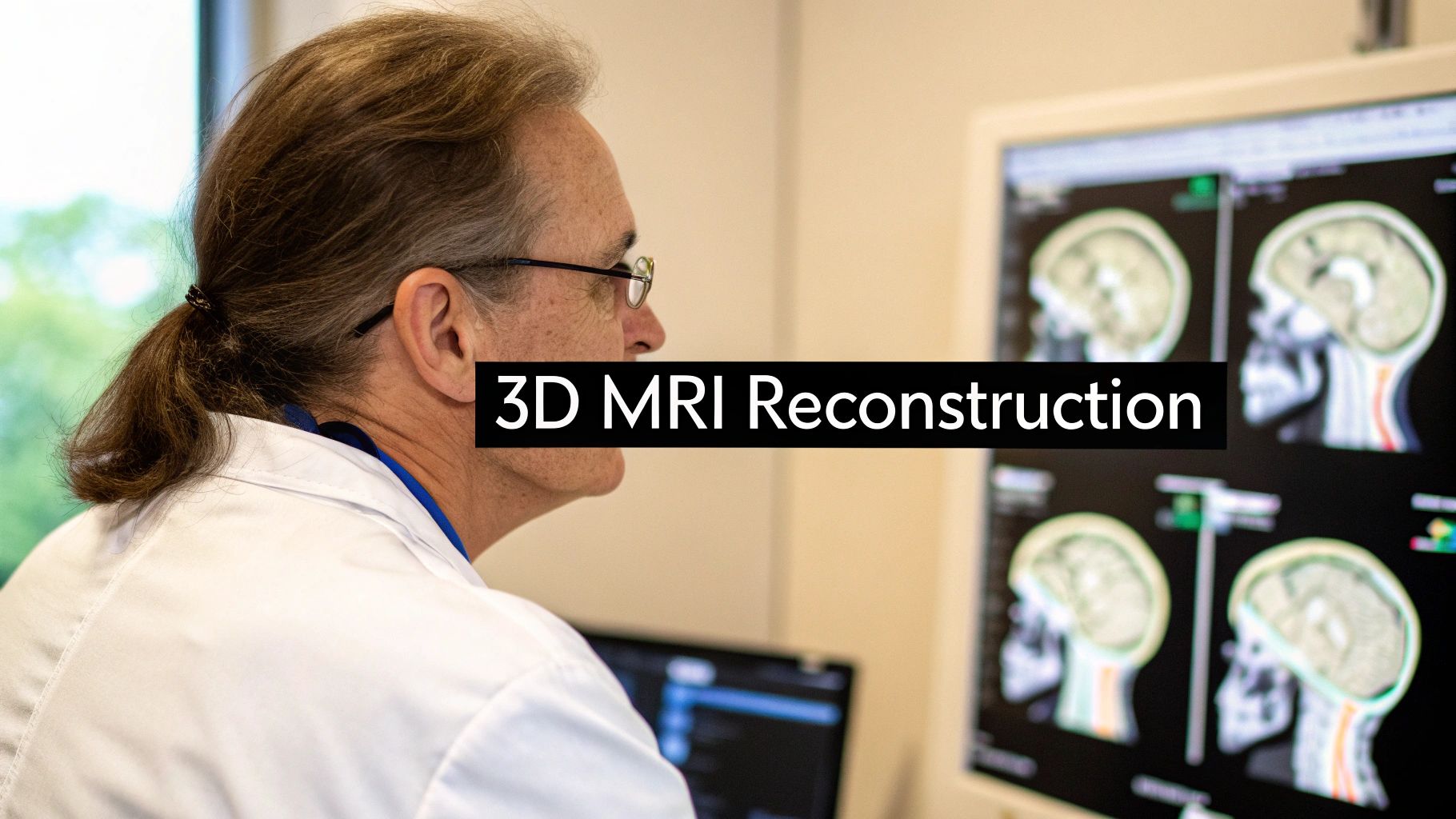The Evolution of Statistical Shape Modeling
Statistical shape modeling (SSM) has become essential in diverse fields, from medical image analysis to computer vision. This technique allows us to analyze and understand shape variations within a population, enabling advancements in personalized medicine and engineering. This section explores the evolution of SSM, highlighting key milestones and its impact.
Early Developments and the Rise of Active Shape Models
Understanding the history of SSM helps us appreciate modern techniques. Just as documentation practices evolve in software development (see Evolution of Documentation in Agile), SSM has adapted to meet new challenges. Its journey began in the 1980s with the introduction of Active Shape Models (ASMs). This marked a significant step forward, allowing researchers to statistically describe shape variability for the first time.
The following timeline illustrates key stages in SSM's evolution:

As the infographic shows, SSM progressed rapidly. From ASMs in 1985, the field adopted Principal Component Analysis (PCA) by 1995 to refine shape analysis. By 2010, the integration of 3D statistical shape models enabled more complex representations of anatomical structures.
Advancements in 3D Modeling and Applications
These early developments formed the basis for future advancements. SSM's theoretical foundation emerged in the 1980s with the ASM, enabling the statistical representation of shape variations. This paved the way for more sophisticated techniques. For instance, modern SSM applications analyze complex structures like cervical spines, building models from volumetric meshes with tens of thousands of nodes (e.g., 54,960 nodes per mesh). These models use PCA to decompose shape variance, with eigenvalues representing the variance captured by each mode. The first few principal components typically capture most of the variance, efficiently representing complex shapes. This has significant implications for biomechanics and clinical decisions, allowing for personalized diagnostics and treatment plans. Learn more about the medical applications of statistical shape modeling here.
Increased computing power fueled this growing complexity. What began as simple 2D applications evolved into sophisticated 3D volumetric representations, capturing the intricate details of biological structures with greater precision. This evolution continues to drive innovation in SSM algorithms and applications.
Demystifying the Mathematics Behind Shape Analysis
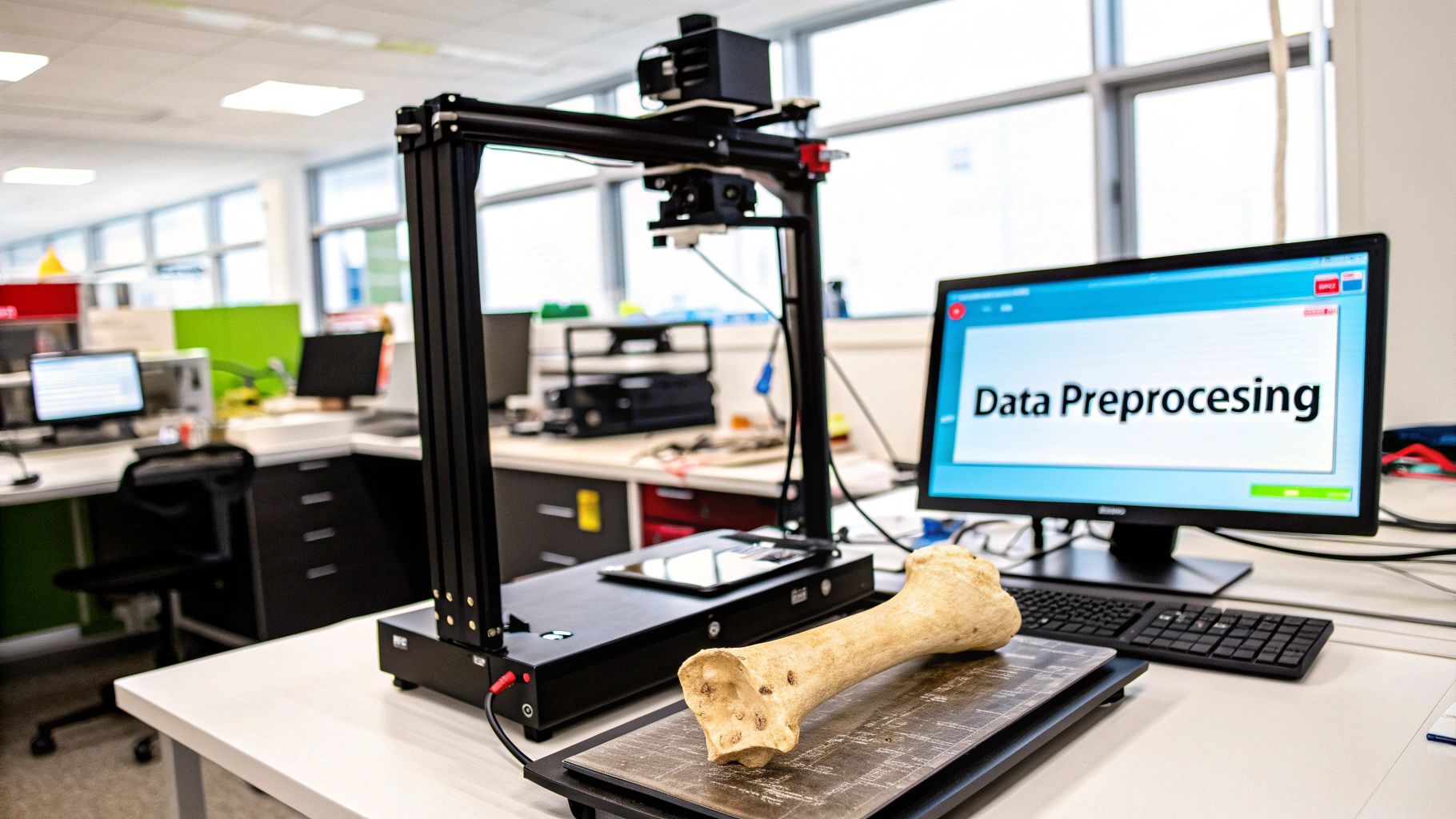
Statistical shape modeling uses several key mathematical techniques to represent and analyze complex 3D shapes. These methods allow computers to understand and process shape information in a meaningful way. This section will break down some of the most important concepts.
Establishing Correspondence Points
The first step in statistical shape modeling is establishing correspondence points. Think of these points as landmarks that identify the same anatomical location on different shapes. Imagine comparing two hands. You wouldn't just overlap them randomly; you'd align key features like fingertips and knuckles.
This is the same principle behind correspondence points. They provide the foundation for comparing and analyzing shape variations. These points are essential for ensuring accurate and meaningful comparisons between different 3D shapes.
Procrustes Alignment and Dimensionality Reduction
After establishing correspondence, Procrustes alignment comes into play. This technique removes variations in position, scale, and rotation between shapes. Think of it as standardizing the shapes, allowing us to focus solely on differences in form. For instance, when comparing faces, Procrustes alignment removes variations due to head size or orientation.
Once aligned, dimensionality reduction techniques simplify the shape representation. A common method is Principal Component Analysis (PCA). PCA identifies the most significant variations in shape, known as principal components. These principal components are like the essential building blocks of shape differences within a set of similar shapes. It's akin to compressing an image file: you retain the crucial features while reducing the data size.
Eigenvalues and Shape Variation
Each principal component has an associated eigenvalue. This value indicates how much that specific component contributes to the overall shape variation. Often, a small number of principal components capture most of the variance. This efficient representation is crucial for practical applications, enabling the analysis of complex shapes with a relatively small number of parameters. This efficiency is particularly important when dealing with large datasets.
To help illustrate these core concepts, the following table provides a summary of the techniques, their purposes, mathematical basis, and roles within Statistical Shape Modeling (SSM):
To summarize the core concepts, let's take a look at a table outlining these techniques:
Essential Mathematical Components of Statistical Shape Models:
This table breaks down the key mathematical techniques used in statistical shape modeling and their specific functions.
| Technique | Purpose | Mathematical Basis | Role in SSM |
|---|---|---|---|
| Correspondence Points | Identify corresponding locations on shapes | Point cloud registration | Foundation for shape comparison |
| Procrustes Alignment | Remove positional, scale, and rotational differences | Least squares fitting | Standardizes shapes for analysis |
| Principal Component Analysis (PCA) | Reduce dimensionality, capture main variations | Eigenvalue decomposition | Simplifies shape representation and analysis |
This table provides a clear breakdown of how each mathematical technique contributes to the overall process of statistical shape modeling. By understanding these core components, we can better appreciate the power of SSM in analyzing and interpreting complex 3D shape data. From medical imaging to computer-aided design, this powerful tool opens doors to a wide range of applications.
From Manual Measurements to Modern Shape Modeling
Imagine Charles Darwin meticulously sketching finch beaks, painstakingly measuring each curve and angle by hand. This traditional approach to shape analysis, while fundamental to early biological studies, had inherent limitations. Today, statistical shape modeling (SSM) allows researchers to analyze thousands of shape points concurrently, revealing intricate details and patterns previously impossible to discern. This shift from manual measurement to digital analysis represents a major advancement in our understanding of anatomical variation.
The journey from manual to modern methods was a gradual evolution. Early tools like calipers gave way to the digital precision of 3D scanners and advanced software like MeshLab. This technological leap empowered researchers to capture and analyze shape data with unprecedented accuracy and detail. Subtle variations, once undetectable, are now readily apparent, enabling more nuanced insights into the complexities of biological structures.
The Role of Parametric Techniques
Parametric techniques are central to modern SSM. These methods utilize mathematical equations to represent shapes, providing a more compact and adaptable format compared to older, manual feature-based approaches. Instead of relying on limited measurements, like the length and width of a bone, parametric models can capture the entire 3D surface. This comprehensive approach captures intricate surface details and subtle variations that provide a much richer understanding of shape complexity.
Machine Learning and the Future of SSM
The integration of machine learning is further propelling the field of SSM. Machine learning algorithms can identify hidden patterns and complex relationships within vast datasets, far exceeding human capabilities. This leads to more accurate and robust shape models capable of encompassing a broader spectrum of variations. This advanced capability is particularly impactful in medical applications, where individual anatomical differences can play a crucial role in treatment planning.
From Morphometrics to Modern SSM
The roots of SSM lie in early 20th-century morphometrics, a field that combined shape analysis with statistical methods. The fusion of classical morphometrics with modern machine learning and advanced techniques like parametric and surface-sampling gave rise to contemporary SSMs. These contemporary methods create population-level shape models, significantly enhancing the precision and level of detail achievable in shape analysis. For instance, in orthopedics, SSMs are now employed for implant design, capturing over 90% of morphological variance with just a few principal components. Learn more about the exciting applications of SSMs at Kitware. Effective shape analysis relies on robust data analysis techniques. For a more comprehensive understanding of these methods, explore this helpful resource on Data Analysis Methods.
Transforming Healthcare Through Shape Analysis
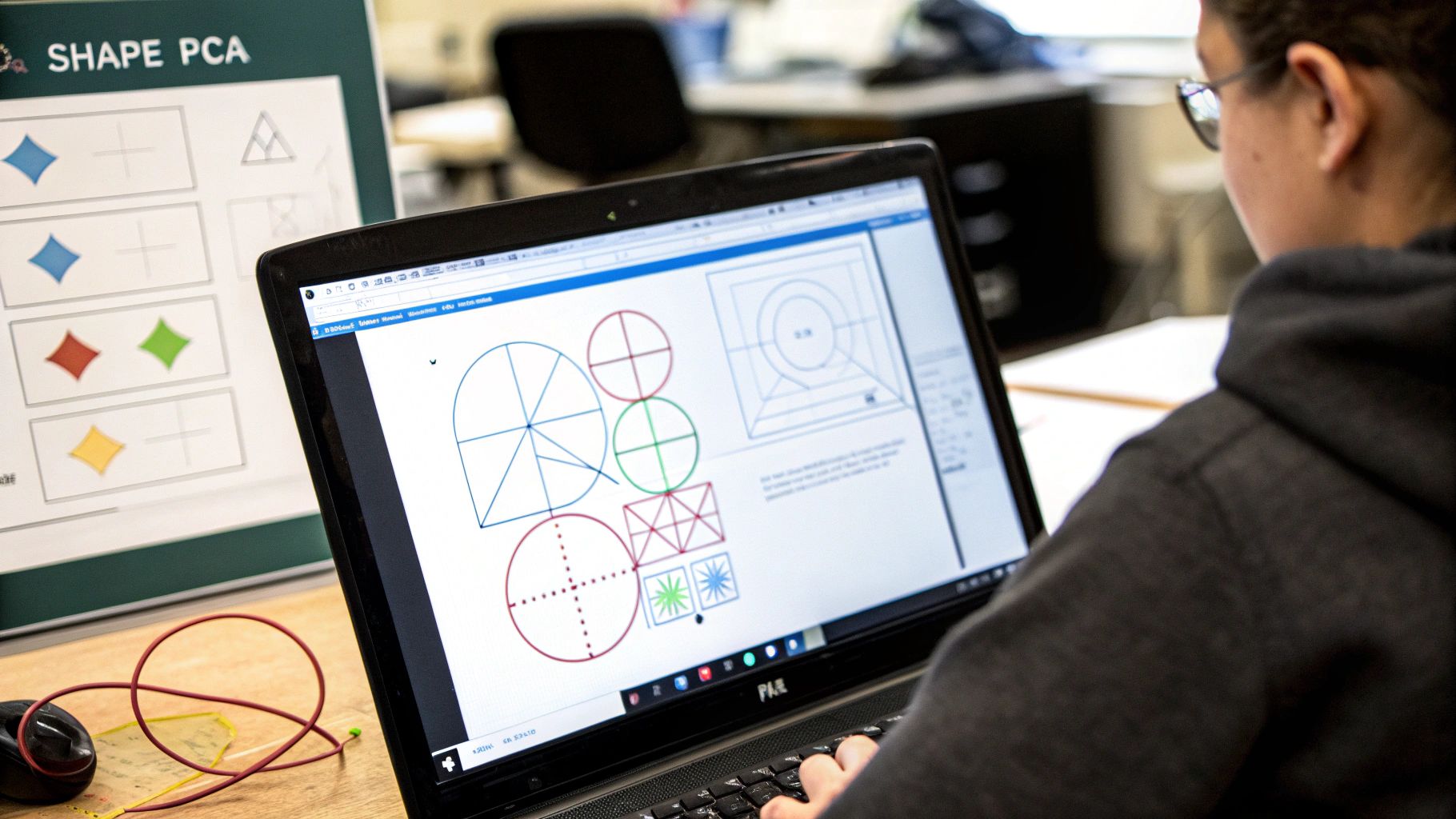
Statistical shape modeling is rapidly changing how patient care is delivered. It offers unprecedented precision and personalization, enhancing both diagnostic accuracy and the effectiveness of treatments across various medical specialties.
Personalized Implants and Surgical Planning
Statistical shape models are significantly impacting surgical planning and implant design. Surgeons use these models to create custom implants perfectly tailored to a patient’s unique anatomy. This personalized approach improves implant fit, which in turn reduces the risk of complications and improves long-term outcomes. This is especially valuable in complex procedures like craniofacial reconstruction and orthopedic surgery.
These models also allow for virtual simulations of surgical procedures before the actual operation. This pre-operative planning helps surgeons anticipate potential challenges and optimize their strategies. The result is shorter operating times and improved patient safety.
Enhanced Diagnostic Accuracy
Statistical shape modeling plays a critical role in improving diagnostic accuracy. Radiologists use these models to identify subtle pathological changes often invisible to the naked eye. Detecting these early signs of disease is crucial for prompt intervention and a better prognosis. For instance, the technology can differentiate between benign and malignant tumors based on tiny variations in their shape.
In orthopedics, these models are used to predict surgical outcomes more accurately. This allows specialists to develop more effective and individualized treatment plans based on a patient’s specific anatomical characteristics. The result is typically better post-surgical results and faster recovery times.
Multi-Organ Modeling and Precision Medicine
Statistical shape modeling isn't limited to single organs. It extends to multi-organ systems, giving a more comprehensive understanding of a patient's anatomy. This holistic perspective is crucial for diagnosing complex conditions involving multiple organ systems and for developing targeted treatment strategies. It also reduces surgical planning time, which is particularly beneficial in urgent cases.
This technology is part of a broader move toward precision medicine. Leading medical centers globally are incorporating these techniques into their precision medicine programs and seeing measurable improvements in both patient satisfaction and clinical outcomes. Increased accuracy in diagnosis and treatment has led to better patient outcomes and greater satisfaction.
Statistical Shape Modeling in Various Medical Fields
To demonstrate the broad applications of this technology, the following table summarizes its use and benefits across various specialties:
To understand its wider impact, let’s look at how statistical shape modeling benefits different medical fields. The table below provides a comparison of its applications, benefits, and current adoption across different medical specialties.
Statistical Shape Modeling Across Medical Specialties
| Medical Specialty | Applications | Benefits | Current Adoption Level |
|---|---|---|---|
| Cardiology | Heart valve analysis, chamber quantification | Improved diagnosis of heart conditions, personalized treatment planning | Increasing rapidly |
| Neuroscience | Brain tumor detection, neurological disorder assessment | Earlier diagnosis, targeted interventions | Growing steadily |
| Orthopedics | Implant design, fracture analysis | Personalized implants, improved surgical outcomes | Widely adopted |
| Radiology | Tumor identification, image segmentation | Enhanced diagnostic accuracy, precise image-guided interventions | Significant adoption |
Statistical shape models have been validated and applied in numerous biomedical fields. For example, in multi-organ analysis, recent advances have allowed the creation of multi-level shape models that can handle large populations Point Set Models (PSM). This technology enables large-scale studies of anatomical variability, crucial for population health research and personalized medicine. Clinical applications of these PSM models, derived from statistical shape modeling methodologies, include image and shape analysis in neuroscience, cardiology, and orthopedics. Research from 2017 onward has documented the successful application of SSM-based PSMs in areas such as brain morphology studies, heart structure modeling, and orthopedic implant design.
As statistical shape modeling continues to evolve, so too will its potential to improve patient care, furthering its integration into the future of healthcare.
Overcoming Critical Implementation Challenges
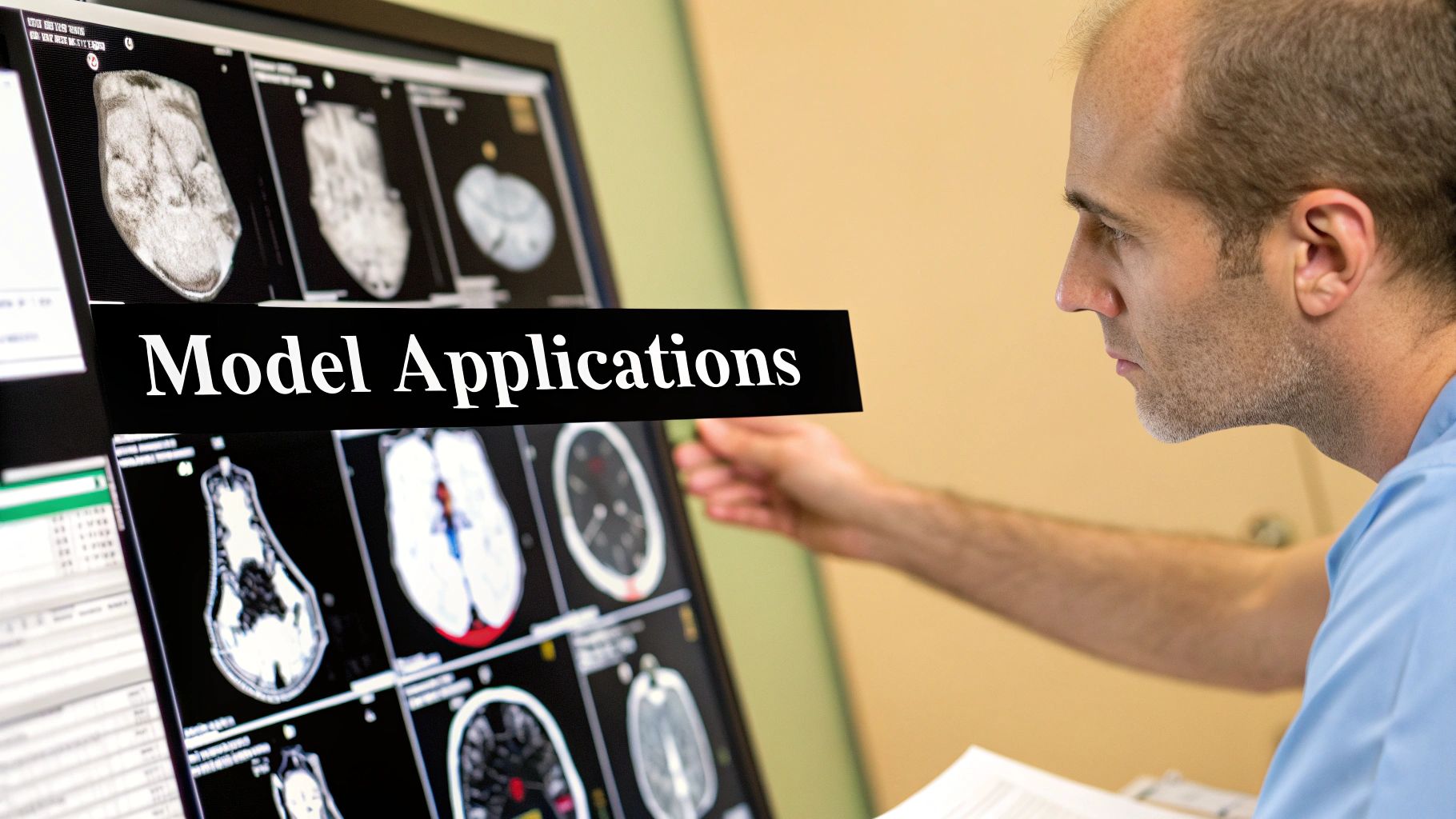
Implementing statistical shape modeling (SSM) presents some real-world hurdles. This section addresses these challenges and offers practical solutions based on expert insights and successful past implementations.
Establishing Reliable Correspondence Points
A crucial step in SSM is establishing correspondence points across different shapes. These points must accurately represent corresponding anatomical locations to ensure meaningful comparisons. However, variations in shape, size, and orientation can make this process complex.
One effective approach is using semi-automatic methods. These combine automated algorithms with manual refinement by experts. This allows for initial automated placement followed by expert adjustments to optimize accuracy.
Another common challenge is handling missing data or incomplete scans, a frequent occurrence in clinical settings. Interpolation techniques can help by estimating missing points based on the surrounding data. This maintains model integrity even with imperfect data. However, validating these interpolated points is essential to avoid introducing inaccuracies.
Managing High-Dimensional Datasets
SSM often involves analyzing complex shapes represented by thousands of points. This results in high-dimensional datasets which can increase computational demands significantly. One solution is dimensionality reduction using techniques like Principal Component Analysis (PCA). PCA identifies the most significant variations, effectively reducing the data while preserving crucial shape information.
Optimizing data storage and processing pipelines is also important. Using efficient data structures and algorithms improves performance, especially with large datasets. This might involve specialized libraries or custom code designed for high-dimensional data.
Handling Messy and Incomplete Data
Clinical data is often messy and incomplete. Medical images can be affected by noise, artifacts, and variations in scanning protocols. Robust pre-processing is key to addressing these issues. Noise reduction filters and image segmentation techniques help clean and prepare the data for SSM, ensuring the model is built on reliable information.
Validating the model against independent datasets is also vital. This assesses its robustness and generalizability to new, unseen data. A robust model should perform well on this data, reflecting its ability to capture true underlying shape variations.
Choosing the Right Modeling Approach
Selecting the appropriate modeling approach is another key challenge. Dense surface models capture fine details but require substantial computational resources. Skeletal representations are computationally more efficient but may sacrifice some detail.
The optimal choice depends on the application and the balance between accuracy and computational cost. A detailed surface model might be necessary for surgical planning, while a skeletal representation could suffice for population-level studies.
Finally, mesh quality optimization and validation protocols are essential. A high-quality mesh, free of errors and artifacts, is crucial for accurate analysis. Validation, such as comparing model predictions to real-world measurements, ensures the model’s reliability for real-world applications.
Emerging Frontiers in Statistical Shape Modeling
Statistical shape modeling (SSM) is a constantly evolving field. This section explores exciting innovations pushing the boundaries of SSM and reshaping how we analyze and understand shapes.
Integrating Deep Learning With Traditional SSM
Researchers are actively exploring the synergy between deep learning and traditional SSM techniques. This hybrid approach combines the strengths of both methods. Deep learning excels at learning complex patterns from large datasets, while traditional SSM offers a robust framework for shape representation and analysis. For example, deep learning can refine the automatic detection of correspondence points, a crucial yet often challenging step in traditional SSM.
This integration is leading to new capabilities in shape prediction and analysis, potentially improving accuracy and efficiency compared to using either method alone. This combination could be especially impactful in medical applications, where subtle shape variations often hold clinical significance.
Generative Models and Data Scarcity
One of the challenges in SSM is the frequent need for extensive, labeled datasets. Generative models, a category of deep learning algorithms, provide a potential solution to this data scarcity issue. These models learn the underlying distribution of a dataset and can then generate new, synthetic shapes with similar characteristics. Think of an artist learning to paint in the style of a master; after studying enough examples, they can create new pieces resembling the original artist's work.
These synthetic datasets can augment existing data or even substitute when real data is limited, expanding SSM's applicability to areas with limited data availability. This is particularly valuable in research where obtaining large, labeled datasets is expensive or time-consuming.
Algorithmic Optimizations for Real-Time Applications
Algorithmic advancements are enabling real-time applications of SSM. This means shape analysis can be performed quickly enough for immediate feedback, which is critical for applications like intraoperative guidance during surgery. Imagine a surgeon receiving real-time feedback on the precise placement of a prosthetic joint during a procedure. This precision can significantly improve surgical outcomes.
These algorithmic improvements focus on faster and more efficient SSM calculations without compromising accuracy. This opens doors for more interactive and responsive applications, further broadening SSM's use in critical real-world scenarios.
Expanding Applications Beyond Traditional Domains
While traditionally applied in fields like medical imaging and computer vision, SSM’s potential extends beyond these domains. Researchers are exploring its use in areas like materials science, industrial design, and the digital humanities.
For example, in materials science, SSM can analyze materials' microstructure and predict their properties. In industrial design, it can optimize product shapes for enhanced performance and aesthetics. In the digital humanities, SSM can analyze and compare historical artifacts, offering new insights into past cultures and technologies.
These diverse applications highlight the versatility and growing importance of statistical shape modeling in addressing real-world problems across various disciplines. As the field progresses, we can anticipate even more innovative and impactful SSM applications in the years to come.
Getting Started: Your Practical Implementation Guide
This guide offers a practical roadmap for implementing statistical shape modeling (SSM). We'll cover the essential steps, software options, and key factors for a robust SSM pipeline.
Choosing The Right Software
Selecting the right software is the first critical step. Several excellent choices cater to various needs and expertise levels.
-
Open-Source Solutions: Platforms like MeshLab offer powerful tools for mesh processing and visualization, essential for SSM workflows. These are often free and customizable.
-
Commercial Packages: Specialized commercial software provides advanced features for particular applications, such as medical image analysis. These often come with dedicated support and user-friendly interfaces.
-
Python Libraries: Libraries like Scikit-learn provide essential statistical analysis and machine learning tools, offering a versatile platform for custom SSM pipelines.
Consider your project's specific requirements and resources when making your selection. Factors like budget, needed features, and team experience play a vital role.
Building Your SSM Pipeline: A Step-By-Step Guide
A typical SSM pipeline involves several key stages:
-
Data Collection: Acquire 3D shape data via methods like 3D scanning or medical imaging. High-quality data at this stage is crucial.
-
Pre-processing: Clean and prepare your data. This might include noise reduction, smoothing, and aligning shapes using methods like Procrustes alignment.
-
Landmark Selection: Identify corresponding points on each shape, known as landmarks or correspondence points. This establishes a consistent basis for shape comparison.
-
Statistical Modeling: Apply techniques like Principal Component Analysis (PCA) to capture the primary modes of shape variation and build a statistical model.
-
Model Validation: Evaluate your model's accuracy and generalizability. This could involve comparing predictions to known measurements or using independent datasets.
Each step is crucial for a robust and reliable SSM model. Careful attention at each stage significantly affects the model's performance.
Key Considerations For Successful Implementation
Several practical points can influence the success of your SSM implementation:
-
Sample Size: An adequate sample size is critical for representing population diversity and ensuring statistically sound results. The required sample size depends on shape complexity and the target accuracy level. For example, hand shape variation might require hundreds of samples, while a complex structure like the spine might need thousands.
-
Data Quality: High-quality data is vital for accurate models. Ensure your data is clean, free from artifacts, and that correspondence points are precisely placed. Maintaining mesh quality with tools like MeshLab, for example, is critical.
-
Population Diversity: Your dataset should reflect the diversity of the target population. This ensures the model's generalizability to various individuals or groups. A model of facial shapes, for instance, should incorporate a diverse range of ages, ethnicities, and genders.
Addressing these considerations will greatly enhance the quality, reliability, and generalizability of your SSM results.
Resources For Continued Learning
Many resources offer continued learning in statistical shape modeling. Online communities, forums, and academic publications offer valuable support. Connecting with peers can help troubleshoot problems and keep you current. Active engagement fosters continuous improvement.
PYCAD, specializing in AI for medical imaging, can help with SSM projects. With expertise in data handling, model training, and deployment, PYCAD offers comprehensive support. Learn more about PYCAD’s AI-powered solutions for medical imaging.

